iMovie
Latest
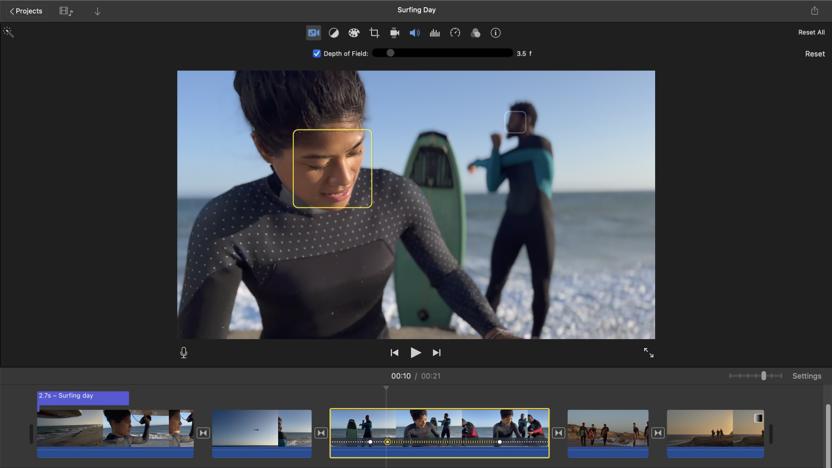
iMovie for macOS Monterey can edit iPhone 13 Cinematic Mode videos
iMovie on the Mac is ready to edit Cinematic Mode videos from your iPhone 13 — if you have macOS Monterey.
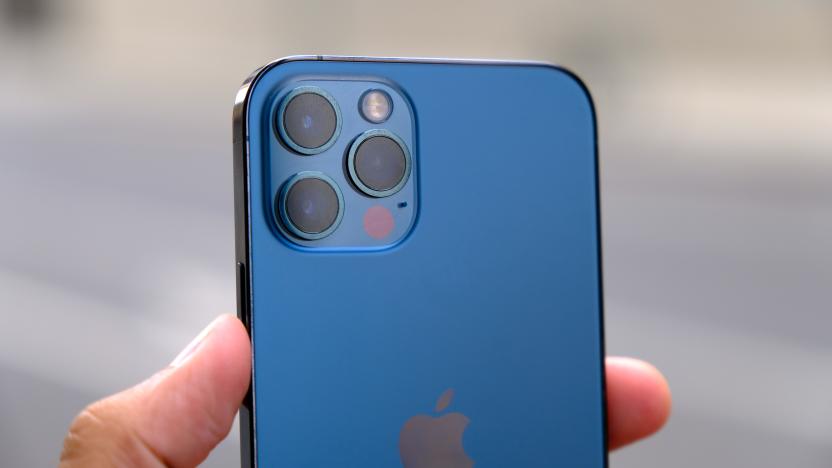
Apple adds HDR support to iMovie just in time for the iPhone 12
One of the iPhone 12 Pro’s most notable features is the ability to record video in Dolby Vision HDR, allowing you to capture footage at up to 60 fps with rich shadows and highlights. Now, Apple has updated its iMovie app for iOS with a bunch of new features, including HDR support, just before the iPhone 12 starts shipping. You can now view, edit and share HDR videos straight from your Photos library even on iPhones older than Apple’s latest flagship devices.

Apple's big iMovie iOS update includes green screen and more
It looks like Apple is taking the casual filmmaker a little more seriously. Its latest update for iMovie for iOS -- out today -- comes with a new green screen effect, better still image support, 80 new soundtracks, graphic overlays and more.
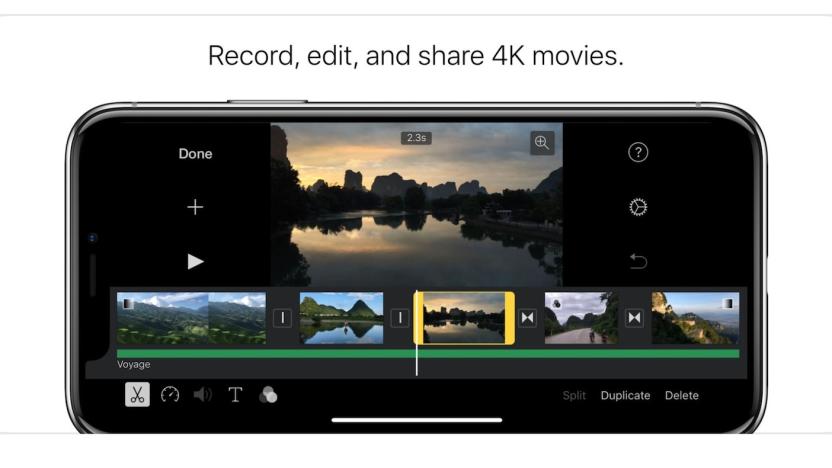
iMovie gets some attention with an iPhone X-ready update
After a few months without updates, Apple has shown some attention to the mobile version of its free iMovie video editor with a new update. It's now fully compatible with the iPhone X's Super Retina Display (and that notch), and according to the notes, finally takes advantage of the Metal API for direct access to your iPhone GPU. Unfortunately, judging by a few early reports, that doesn't seem to do much for video rendering time, but maybe there are benefits that just haven't been uncovered yet.
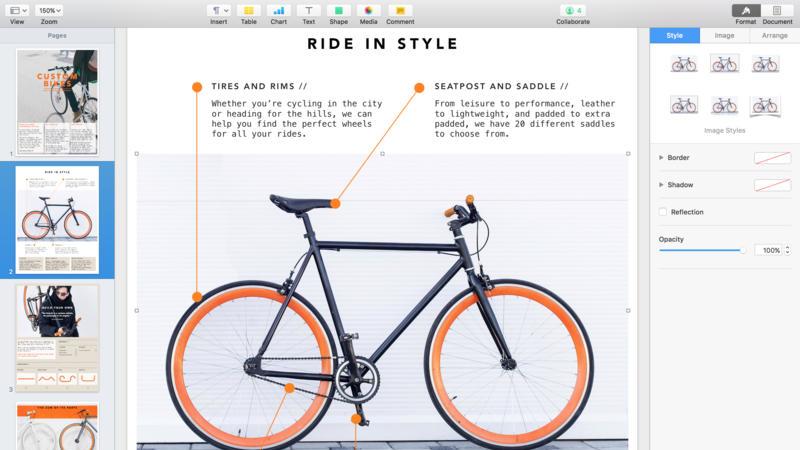
Apple's iWork, GarageBand and iMovie are now free
If you've bought an iOS or Mac device in the past few years, Apple's suite of creativity and productivity apps was effectively free for you. Sure, you had to pay for that expensive tablet or laptop, but the apps themselves were included in the purchase, even if you didn't download them until later. Starting today, however, Apple is simplifying things and making Keynote, Numbers, Pages, iMovie and GarageBand all free in the App Store for anyone in their ecosystem.
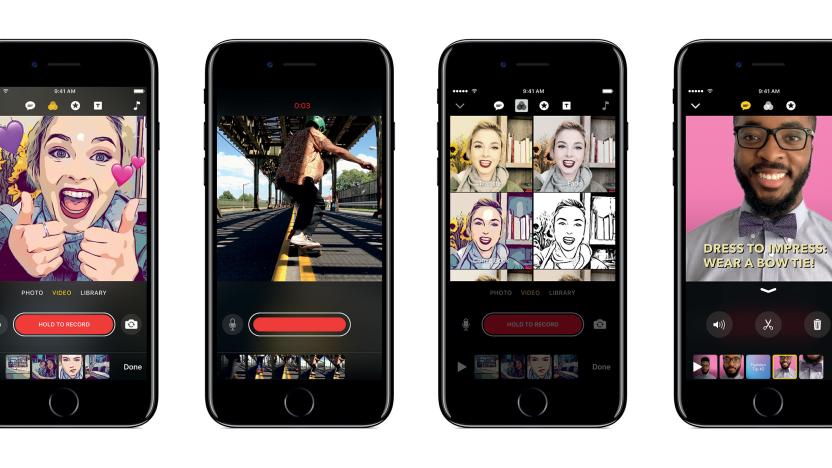
Apple's Clips app hits iOS today to make video creation a cinch
Remember that time Apple launched an iOS app called Clips so people could go forth and pepper their social networks with cleverly edited videos? Well, you probably don't, because it hasn't happened yet. Soon, though! If everything goes according to plan, you'll be able to grab it from the App Store at around 1 PM (Eastern) this afternoon. In the meantime, we've spent a little more time with Apple's new video-editing app. Despite its dead-simple interface, Clips is capable of some pretty impressive feats.

iMovie for Macs goes 4K, lets you continue edits from iOS
Just in time for new 4K and 5K iMacs, Apple released a major update of iMovie for OS X that adds 4K video editing, along with a slew of other changes. The iOS version of iMovie got 4K support last month to coincide with the debut of the iPhone 6s. Now that both versions of the movie editing suite support higher res video, you'll also be able to continue edits on your Mac that you've started with your iPhone or iPad. The updates won't bring professionals to iMovie anytime soon, but it could encourage regular consumers to explore the wonders of editing (so your family isn't stuck viewing your 30-minute home movie clips). Additionally, the new iMovie also supports 1080p at 60 frames per second for smoother footage, which is ideal for shooting sports and other action-heavy clips.

iMovie for iOS is ready to handle your 4K video editing
If you're determined to produce a 4K masterpiece on an iPhone 6s, 6s Plus or iPad Pro, you now have one of the tools you need to get the job done. Apple has delivered an iMovie update that switches on 4K editing for its most powerful iPhones and iPads, giving you an easy (though not professional-grade) way to edit extra-sharp videos on the move. You can't capture 4K on the iPad Pro, alas, but it's powerful enough to edit multiple 4K streams. The giganto-tablet also has room for a larger media browser and a video viewer that shows every single pixel of a 1080p clip.

An edge-case perspective of Apple
Throughout the last decade, reading rumors about Apple products gave me an edge-case perspective of Apple. With each new rumor, I have an internal discussion that determines the validity with a "yes" or a "no." In the past couple years, the dialogue changed from "yeah, that would be cool" to "please, no." Unfortunately for me, my objections often go unaddressed as Apple heads in a direction I find unappealing. So why did that happen? Apple changed, but more realistically... I changed. Let's start with how I changed. Ten years ago, I was only eighteen and in the military. I bought an iPod Photo with my first credit card. I loved music and basked in it while studying for my military knowledge tests. A company called Apple filled this stressed out teenager's need for simplification with a portable music collection that I could fit in my pocket. I was impressed and kept watching Apple. Moving forward a few years, I was tired of carrying around my iPod and my LG flip phone. There was a short period where I tried the Motorola ROKR, but that was a terrible device with very little storage. Again, Apple stepped in and filled a need for simplification by introducing iPhone. During this era, I also picked up a Mac and fell in love with the creativity it allowed; for the first time, it seemed like the software stepped out of the way and I could just create. About the same time, Apple introduced the Apple TV, then the iPod touch, and finally iPad. None of those devices really filled a need for me. Sure, there's some convenience to having every Apple product in existence... but there's really no need for it. I have an Apple TV, an iPad, and an iPod touch now, but my iPhone and my Mac receive 90 percent of my daily attention. As I've aged, my needs changed, and my desire for new technology products has dwindled. (I'm more interested in seeing developers push the limits of our software, but that's not the point of this piece.) I'm constantly using my Mac for work, and my iPhone handles my free-time interactions. I bought my iPad mainly for reading, but I largely prefer a real book when given a choice. I bought my Apple TV for media sharing, but I don't have a cable or Netflix subscription so some of the built-in capabilities are useless to me. I bought my iPod touch for... well, I didn't actually buy it; one of my customers didn't want to fix it so I bartered other work and fixed it for myself. I haven't used it much. I apologize if I sound elitist here – in fact, most of my Apple devices are hand-me-downs from my repair company customers. For work, I have to stay well educated in the world of Apple; having a wide range of devices is crucial to my success as an Apple consultant. I always say that I know too much about Apple and how it thinks because there's no sense of mystery left for me. My friends call me "The Apple Guy" and often ask to chat about what they read on rumor sites. That would be awesome if I were more interested in the choices Apple makes. Examining Apple hardware Let's switch gears and talk about how Apple changed our hardware over the last ten years. They started with the iPod, its so-called halo effect, and increased Mac adoption. Shortly thereafter, they introduced the iPhone (and another halo effect for the Mac). I would consider all of these products revolutionary. Sure, the iMac in 1998 was amazing, but it really took the halo effect, Justin Long, and the switch to Intel processors to push the Mac back into the mind of the consumer. Since then, everything appears evolutionary to me. I do not discount the amazing progress we've seen in the capabilities of these devices, but they remain largely unchanged in scope. One can argue that the iPad was revolutionary – for a lot of people it was – but it only accounts for 10 percent of my usage. If you ask my wife, it's about fifty-fifty between iPad and iPhone; she doesn't use a computer outside of work. For some people, the iPad serves as their primary device. I think Apple's really targeting that demographic at this point. More on that thought in a bit. Examining Apple software Let's stop talking about hardware and address the software changes Apple introduced in the last ten years. The evolution of OS X is ongoing. In my industry, I cannot look at new software like candy and eat it immediately. Every recent dot release had major issues that hurt a lot of my customers... and I haven't seen it get better over the years. It's not worth discussing specifics here: they are irrelevant to this article, and they were very different depending on customer needs. The same things happen with major iOS updates; the biggest complaint is always battery life. Forget about the OS for a minute and think about the app updates released in the last few years. Apple consistently removes features from apps to help define the difference between consumer and prosumer or to create feature parity between Mac and iOS versions. iMovie and GarageBand seem largely worthless at this point because Apple wants you to upgrade to Final Cut Pro X and Logic Pro X. Aperture is dead in favor of an unreleased Photos app that assuredly focuses on consumers. iWork only recently updated to a usable app after Apple nerfed it last year; it's still not the powerhouse of old. The built-in creative capabilities of a brand new Apple device fail to exceed (they don't even compete with) those of my first generation MacBook. Instead, you have to rely on third-party – usually paid – software to fill in the gaps. Whether from Apple, Adobe, or another third-party developer, paid software is a must for anyone wanting to do something beyond the most rudimentary functions of the default software. However, most people would never notice the lack of creativity. I'm convinced that Apple knows this and changed its entire business model to reflect it. Realizing I'm not the focus Ultimately, I am an edge case. I want my devices to function in ways the average user would not. I want Apple to move into categories where their market research doesn't see profitability. Apple does not, and likely cannot, consider an edge case like me. My edge-case perspective of Apple doesn't align with its target demographic at this point. The first time I realized I was no longer Apple's primary focus was the introduction of Lion and its Server app. It crippled much of my business-related Mac use. I eventually switched to Ubuntu for most server-related activities, and I couldn't be happier. Still, Apple forced my hand by releasing terrible server software; that left a bad taste in my mouth. More recently, iOS 7 confirmed my suspicions that I wanted a different product than Apple wanted to create. Apparently, Apple's market research suggested that people wanted a freshly updated interface. In six years, we hadn't seen a major refresh to the iOS interface design. Some developers, like Tapbots, were taking strides to refresh the interface but Apple felt like it had to do something drastic to keep consumers interested in their products. During this time, we saw executive turmoil at Apple as Jony Ive took over interface design from Scott Forstall. I'm not arguing that skeuomorphic, minimalist, or flat design is better, but I will say that rushing a major redesign seems negligent. I still believe that iOS 7 was a regression in design and usability mostly because Apple pushed it out too quickly and left many consumers scratching their heads. Remember how bad the calendar app was in the initial release? It left many people scrambling to find an alternative like Fantastical. Yes, it's great for third-party developers, but doesn't this sound eerily familiar to the Mac app situation I mentioned earlier? Is the built-in value of Apple devices diminishing? The future looks edgy I'm afraid that Apple is pushing OS X 10.10 Yosemite in a similar direction. I know better than to criticize an unfinished product. I will however express concern about the timing of the release: I'm not sure Apple has enough time to fix all of the interface issues before the public release this fall. It feels rushed at this point. I want it to feel polished; I'm hoping they make the upgrade exciting instead of regrettable. From an iOS perspective, I'm excited for iOS 8 and the added APIs that will push the evolution of iOS forward. I can't wait for a TextExpander keyboard and a 1Password Safari extension. I still don't agree with some of the user interface choices, but it already seems more polished than iOS 7 ever did. The software coming to my truck looks appealing too. My CarPlay-compatible stereo is already installed and awaiting a firmware update from Pioneer and Apple. The upcoming Apple TV software update looks like an improvement, but it's still a far cry from what it should be. I often remind myself that the living room revolution is largely dependent on the cooperation of the television and movie industry. Without their support, Apple can't do much more in the living room... unless it produces a gaming console. Unfortunately, I think the company hopes to continue using the horsepower of your iPhone or iPad to generate large screen gaming. Desiring revolutionary products If Apple wants to revolutionize how we interact with our technology, CarPlay and Apple TV are where I wish they'd spend their time. I believe Apple could easily disrupt those industries with a little more effort, but I'm just an edge case. If rumors prove to be true, Apple seems more concerned with larger phones and smart watches at this point; that doesn't excite me. As I mentioned earlier, my favorite Apple products filled a need in my life. iPod, iPhone, Mac – those products simplified something for me. I'd really like to see Apple focus on filling a need we all share. Is a bigger screen on an iPhone going to do that? I don't think so; I'm not interested in a bigger screen. Can a smart watch fill a common need? I don't think so; I see too many drawbacks in a largely unproven category to consider it worthwhile. Biometric monitoring could certainly change lives, but that seems more like an edge case than a general need... at least to me. I also want to comment on the possible inclusion of sapphire glass in the next generation iPhone. It will be great for Apple, but it's terrible for clumsy phone users everywhere. Most people think the hardness of a material makes it less breakable. That's actually not true; sapphire is more scratch-resistant than gorilla glass, but it's also more brittle. Check out this video if you don't believe me. Ultimately, I want to eat these words on September 9th. I hope that whatever Apple introduces excites me as much as the first iPod or the first iPhone. Historically, Apple has seldom been first to market: MP3 players, smartphones, and tablets – those categories existed before Apple stepped in and obliterated the competition. Whatever they introduce on Tuesday, I want it to be more disruptive than their recent, evolutionary products. Continued Apple dominance Either way, Apple isn't doomed. Analysts and consumers seemed pacified after the release of iOS 7 simply because it was different. Apple shares are near an all-time high, no other company can touch their market cap, and the company has a ridiculous amount of money in the bank. My jaded perception of Apple's recent products hasn't meant a thing to its success because people keep buying them. If you share my sentiments, keep reminding yourself that the edge case rarely receives attention. Apple's target demographic doesn't mind having U2 at the keynote, likes bigger screens because the text is too small, and thinks watches are cool. I'm very far removed from that demographic at this point. Maybe someday my edge-case perspective will shift back into the mainstream. It would be nice to get excited again, wouldn't it?

The TUAW Daily Update Podcast for July 2, 2014
It's the TUAW Daily Update, your source for Apple news in a convenient audio format. You'll get some the top Apple stories of the day in three to five minutes for a quick review of what's happening in the Apple world. You can listen to today's Apple stories by clicking the player at the top of the page. The Daily Update has been moved to a new podcast host in the past few days. Current listeners should delete the old podcast subscription and subscribe to the new feed in the iTunes Store here. Note that due to out company holiday schedule, the Daily Update Podcast will not be available on July 3 or 4. We'll be back the afternoon of July 7 to bring you more Apple news in a hurry.
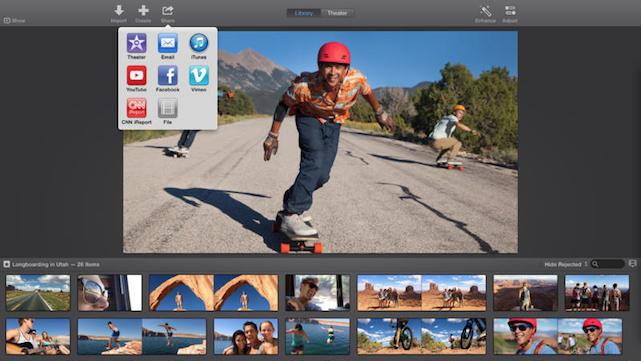
iMovie update fixes crashing issue
Apple has released iMovie 10.0.04 just in time for editing all the video from your summer adventures. The update doesn't bring any major new features to iMovie, but it does provide improved stability and fixes issues that have previously caused the app to crash in the middle of editing. The company last updated iMovie in April, introducing new features for sorting content, new font options, slight interface changes, and upgraded titles. That upgrade also included a crash fix for the app. You can download iMovie's latest update for free if you've already purchased the program, otherwise it will set you back US$14.99 in the Mac App Store.

Daily Update for November 21, 2013
It's the TUAW Daily Update, your source for Apple news in a convenient audio format. You'll get all the top Apple stories of the day in three to five minutes for a quick review of what's happening in the Apple world. You can listen to today's Apple stories by clicking the inline player (requires Flash) or the non-Flash link below. To subscribe to the podcast for daily listening through iTunes, click here. No Flash? Click here to listen. Subscribe via RSS

Apple updates iMovie, adds support for older Macs
Apple has released an update to its new iMovie software for OS X. Though the minor update offers the usual bug fixes, there is one major improvement those with older Macs will be interested in: The latest iMovie can now be installed on computers with some older video cards. Previously the latest iMovie required a Mac with an OpenCL-capable video card installed, but with the 10.0.1 update, any Mac that can run OS X Mavericks can now install and run the app. Besides support for older Macs, iMovie 10.0.1 also addresses reliability issues when updating projects and events from previous versions of iMovie. iMovie is US$14.99 in the Mac App Store.

iMovie Theater channel added to the Apple TV
If you turn on your Apple TV you may notice a new channel called iMovie Theater. Apple quietly added the channel tonight. The channel itself is an extension of a feature in the new iMovie app for iOS and OS X that allows users to share clips, movies, and trailers to iMovie Theater and watch them anywhere -- on the Mac, iPad, iPhone, iPod touch, or Apple TV. If you don't see the new iMovie Theater channel, simply restart your Apple TV and it should appear.
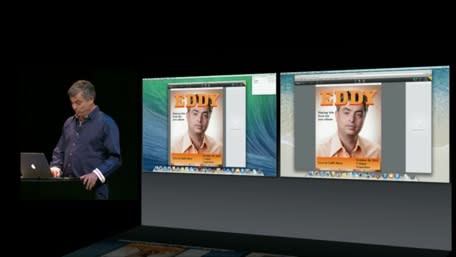
iLife apps get major updates, out today
Today at Apple's event in San Francisco, we got a glimpse at the iOS 7-minded updates to the company's popular iLife apps. These refreshed versions will be available today in the App Store. First up was iPhoto, which has been redesigned for iPhone and iPad in the same ultra-modern style of iOS 7. The layout is much cleaner and the photos appear larger than before. Apple is also adding the ability to construct a photo album on your iDevice and then order a physical copy directly from Apple. iMovie receives a similar treatment, with much less clutter and larger icons. Browsing and sharing have also been simplified, and users can now select clips and tap to share them. New features for moviemaking include the ability to add picture-in-picture to clips and also speed up or slow down segments. Using iCloud, clips can be synced over all your devices as well as Apple TV. GarageBand is now more capable, now allowing up to 16 tracks across all devices and a whopping 32 tracks on 64-bit devices. A new "Drummer" feature adds a controllable drum beat that can be manipulated to fit your tunes. Additional drummer "personalities" will be able to be downloaded via in-app purchases. iLife is now free on all new iOS and Mac devices.

5 QuickTime Player Secrets
It's easy to overlook the power of the steady and dependable QuickTime Player. Built right into OS X, many users don't necessarily think of it as a sophisticated app. Despite that, Apple has engineered some great features for it. Here are five of our faves. Change the playback rate. When you're watching a lecture or presentation, sometimes you want to help speed things up so you can move through material a little faster. QuickTime Player supports this. Just click and hold on the play-pause button for about 5 seconds to access the rate change menu. It enables you to speed up or slow down the video playback rate with fine granularity. Edit the video. Press Command-E or choose View > Show Clips to enter QuickTime Player's edit mode. Here, you can split your video into clips, trim away sections you want gone, adjust clip order, and more. You don't need to track down an old copy of QuickTime Pro or fire up iMovie for simple edits. Scrub. QuickTime Player offers several ways to scrub your video. First, you can drag the play head along the scrub bar to set a rough position. You can also use the arrow keys to move frame-by-frame. With playback stopped, if you press and hold the play head for about 2-3 seconds, the scrub bar converts to a manageable 20-second range instead. Play Video Backwards. QuickTime Player offers a number of arrow key functions that go beyond simple scrubbing. For example, holding the Option key lets you jump to the start or end of your video. What's really cool is when you press Command-Left-Arrow. Your video starts playing in reverse. Repeat that key sequence to change the rate at which your movie plays backwards. (The same trick holds for normal playback. Command-Right-Arrow goes from normal play to accelerated options.) Float Your Video. A lot of people try to get some work done as they watch their favorite videos. But having Safari or Mail cover parts of the video can get really annoying. To ensure that your video gets the priority it needs to stay on top of all other windows, choose View > Float on Top. This option pushes the video to the front of the windowing system, ensuring that it won't be obscured.

Apple wisely brings its iLife strategy to the iPhone and iPad
Perhaps lost in the shuffle amidst a slew of announcements on Tuesday is that Apple is making its fleet of iWork apps available free for download on new iOS devices. In addition to Pages, Keynote and Numbers, users will also be able to download iMovie and iPhoto free of charge. Think about that for a second; in one fell swoop, Apple made its entire range of productivity and creativity apps (save for GarageBand) available for free. As it stands now, purchasing all of the aforementioned apps would set you back US$40. This is significant on a number of levels, and harkens back to Apple's strategy with the Mac when it first began introducing what would soon become a formidable collection of apps that together comprised Apple's iLife suite of software -- iTunes, iMovie, iPhoto, iDVD (now defunct), iWeb (also defunct) and, last but not least, GarageBand. Steve Jobs first introduced Apple's "Digital Hub" strategy back at Macworld in 2001 (though iMovie had already existed at that point). "If you use iMovie," Jobs boasted during a vintage performance, "it makes your digital camcorder worth 10 times as much because you can convert raw footage into an incredible movie." In relaying the thought process behind Apple's digital hub strategy, Jobs explained that the "glue that's going to make all this happen are the applications: iMovie. iTunes. iDVD. They are going to be our passport into our new digital lifestyle era." And Jobs was spot on. Macs in the early 2000s began shipping with powerful software applications that enabled users to harness their creative juices and manage their digital media right out of the box. I myself was a heavy iMovie user early on and remember being blown away by what was now possible. While my videos were hardly award-winning productions, my friends would often excitedly remark, "You were able to do that on your computer? And the software to do that just comes with it for free?" Once iPhoto hit the scene in 2002, soon followed by GarageBand in 2004, Apple's suite of iLife software really empowered the average user to create ambitious and professional-grade projects. Apple's iLife strategy with the Mac provided a value proposition that was simply unmatched on the Windows side. While it's impossible to quantify how many Macs were sold on account iLife, there's no denying that iMovie and its brethren created a lot of happy customers who became reliant upon and excited about the Apple ecosystem. Now, Apple is taking that same strategy and applying it to iOS. While the aforementioned iOS apps won't be pre-loaded, they will be available as free downloads on new iOS devices. Much like the Mac, this strategy aims to enhance the value of iOS devices, especially when measured against competing devices from the likes of Android and, well, I guess mostly Android. During yesterday's event, Tim Cook explained: We think that iWork is a really key advantage for our customers' productivity, and that iPhoto and iMovie are great for are customers creativity. No other platform has any apps like these. We think that all iOS devices are made even better if they have these apps. And almost all of our customers want these apps. Sounds a lot like Jobs back in 2001, right? iLife on the Mac put powerful media creation tools at the forefront of the PC user experience. Now, Apple is implementing the very same strategy for iOS and it's hard to see this as anything but a savvy business move on Apple's part. Out of the box, productivity and media-creation tools will be more accessible and intuitive on iOS than on any other mobile platform. Well played Apple, well played.

Apple updates iLife for iOS apps
Apple has released updates to the iLife apps for iOS. The company says the updates to iPhoto and iMovie address compatibility issues, while the update to GarageBand addresses minor issues related to general performance and stability. The "compatibility issues" may or may not relate to iOS 7, which is expected to be released to the public in the next several weeks. However, since the updated iLife apps don't feature any new iOS 7-inspired icons, it's likely that Apple will push out further updates to them once iOS 7 ships. iPhoto, iMovie and GarageBand for iOS are available in the App Store for US$4.99 each.

Apple this summer to offer camp where kids can learn how to 'become filmmakers'
Apple this summer will be offering another film-focused session of Apple Camp where kids ages 8-12 will be able learn all the finer points about film production. The camp is free and takes place at Apple retail stores. On its website, Apple touts the camp as a fun workshop "where kids become filmmakers." Over the course of three days, Apple employees will teach campers everything from creating a storyboard, to crafting a song in GarageBand and of course, how to film and subsequently edit video footage in iMovie. On the third and final day of each session, the camp will hold a film festival of sorts where kids will be able to showcase their films to friends and family. Each session over the three-day period lasts 1.5 hours and parents interested in signing up their kids can check out Apple's website to see which dates still have openings. I checked a few Apple retail stores and it's advisable to sign up soon since spots already seem to be filling up quickly. It also seems that each participating retail store will offer 12 distinct three-day sessions with the first session slated to begin on July 15 and the last session set to begin on July 31. Lastly, Apple notes that it will supply campers with all of the tools they'll need to get a film up and running. If possible, however, campers are encouraged to bring their own Mac and video camera.

iMovie update 9.0.9 released
A minor update for iMovie has been released. Version 9.0.9 fixes issues where iMovie didn't recognize when video cameras were connected to the computer, adds improved compatibility with iMovie for iOS projects and includes the usual stability improvements. The update is currently available for download in the App Store.











